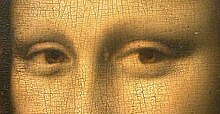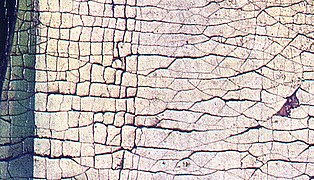Craquelure



The craquelé (e), craquelure ( French: craqueler , "let crack "; craquelé , "cracked, jumped") is a jump or crack network in oil paintings , stones , gemstones , varnishes , glass surfaces , glazes of ceramic objects or in wall paintings , Facade plastering and painting occurs or can occur. Craquelé can arise during the production of an object due to incorrect structure ( early shrinkage cracks ), in the course of its aging (age jump) due to mechanical stress ( climate fluctuations , transport ), but also as a desired effect due to a corresponding painting technique ("lean on fat"), or is made artificially with a tear varnish .
Glass
Crackled glass offers a special visual attraction due to the impression of great fragility.
Ceramics
In ceramic production, the crackle forms due to the different expansion coefficients of the substrate and glaze during firing; in particular the raku ceramic produced in Japan has corresponding surfaces.
With light tin / lead glazes (such as the base glaze in majolica or faience ), the hairline cracks fill up with darker particles over time and become more and more visible. Dark and opaque glazes, such as the "bottle green" often used for older tiled stoves, have less of a tendency to darken the cracks in the glaze;
With glazed oven tiles , which have to be particularly heat-resistant, the fine cracks in the glaze occur more frequently. This is particularly desirable for very large tiles. This makes the ceramic more robust against breakage due to temperature fluctuations, since the less flexible glaze can "go along" with the more rapidly expanding ceramic body.
Gemstones are artificially scratched by heating the stone and quickly cooling it down again. The cracks can be highlighted with a color polish.
painting
Probably the most noticeable sign of age and change in the image layer of paintings is craquelure, which influences their appearance to a greater or lesser extent. Craquelé is a crack or crack network that can usually be seen more or less clearly on every older painting. It depends on the materials used in the painting ( image carrier , pigments , binders ), on the atmospheric conditions to which a painting is / was exposed and on the way it was treated by the manufacturer, the owners and / or the painting restorers . The paintings customer differentiates between cracks and cracks. Cracks are mechanical or atmospheric (age gap), are not wider than about 0.5 mm and always extend to the image carrier. Cracks, more precisely early shrinkage cracks, are caused by the painting technique, from about 1 mm wide and extend at most to the primer. In some cases the boundaries between cracks and cracks can be blurred, i.e. H. Cracks can run into the depths of wide cracks. The appearance of a craquelé is of great importance when it comes to the preservation, authenticity and age of a painting.
An artificial crackle effect can be created with rice lacquer or crackling lacquer (also called crackling medium), which is available in handicrafts. Cracked varnish contracts as it dries, forming a pattern of cracks. This should create an "antique" or "historical" appearance through the otherwise transparent paintwork.
Fake craquelure
A fake painting needs artificially made cracks and fissures to look like an original. Craquelé forgeries can be created through a specific structure of the paint layer (“bold” to “lean”), by drawing, painting on, scratching or by the various possibilities of “breaking” or “blasting” the paint layer.
If the forger puts a fast-drying layer of paint on a slow-drying (oxidizing) layer of paint that usually contains a lot of oil, early shrinkage cracks occur. In most cases, the artificially created early shrinkage cracks evenly cover the entire painting, while original early shrinkage cracks occur partially, often limited to certain colors, and differ in shape and size. Painted, drawn and incised craquelé shapes only remain undetected when viewed superficially. They cannot withstand an examination with a magnifying glass or a stereo microscope (macro examination). They lie on / in the top layer of paint and show no "break". The incised craquelé also looks more like a furrow when enlarged and differs significantly from the naturally created cracks.
weathering
Weathered surfaces such as tar surfaces or plastic surfaces also develop a crackle-like appearance.
Examples
Raku plate
Grain
container, Vietnam , 11./12. CenturyWeathering notice on a glass recycling container
literature
- Knut Nicolaus: DuMont's picture lexicon to identify paintings. DuMont Buchverlag, Cologne 1982, ISBN 3-7701-1243-1
- Knut Nicolaus: DuMont's handbook of painting. DuMont Buchverlag, Cologne 2003, ISBN 3-8321-7288-2
- Knut Nicolaus: Handbook of painting restoration. Könemann, Cologne undated (2001)
Web links
Individual evidence
- ↑ Crack. In: ICOMOS, International Scientific Committee for Stone [ISCS] (Ed.): Illustrated Glossary on Stone Deterioration Patterns, Illustrated glossary of the weathering forms of natural stone . Michael Imhof, Petersberg 2010, ISBN 978-3-86568-667-1 , p. 10 ( icomos.org [PDF]).
- ↑ Knut Nicolaus: DuMont's picture lexicon for determining paintings . DuMont Buchverlag, Cologne 1982, ISBN 3-7701-1243-1 .
- ↑ Craquelée. In: Angela Weyer et al. (Ed.): EwaGlos. European Illustrated Glossary Of Conservation Terms For Wall Paintings And Architectural Surfaces . English Definitions with translations into Bulgarian, Croatian, French, German, Hungarian, Italian, Polish, Romanian, Spanish and Turkish. Michael Imhof, Petersberg 2015, ISBN 978-3-7319-0260-7 , p. 208 , doi : 10.5165 / hawk-hhg / 233 .
- ↑ Knut Nicolaus: DuMont's picture lexicon for determining paintings . DuMont Buchverlag, Cologne 1982, ISBN 3-7701-1243-1 , p. 49-52 .











